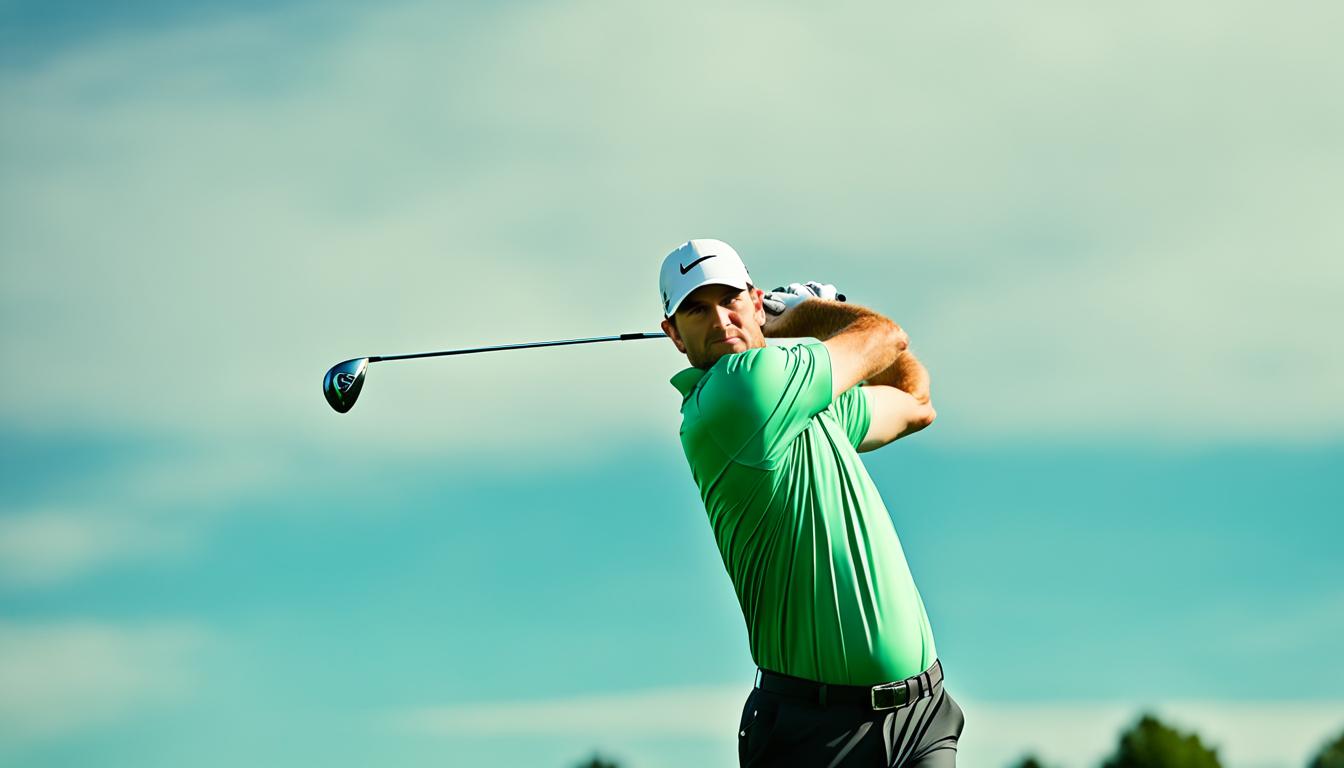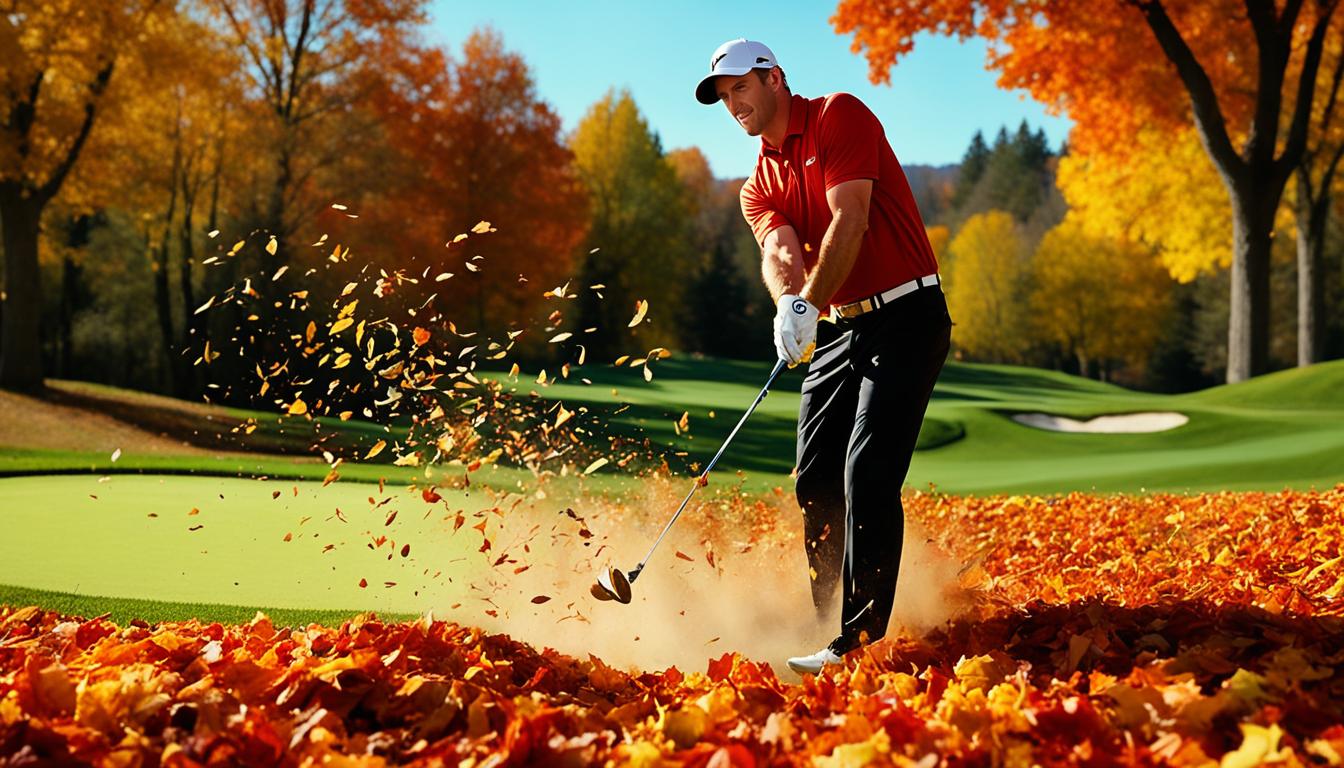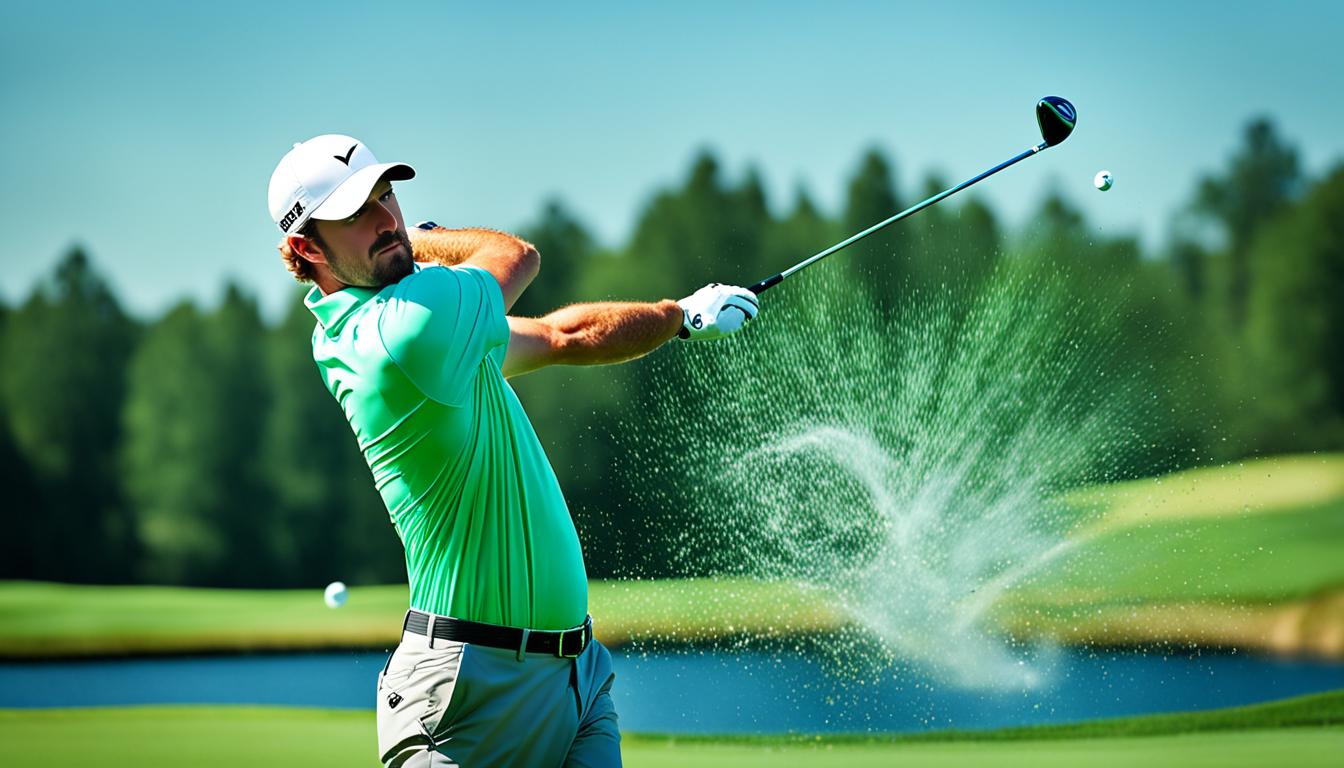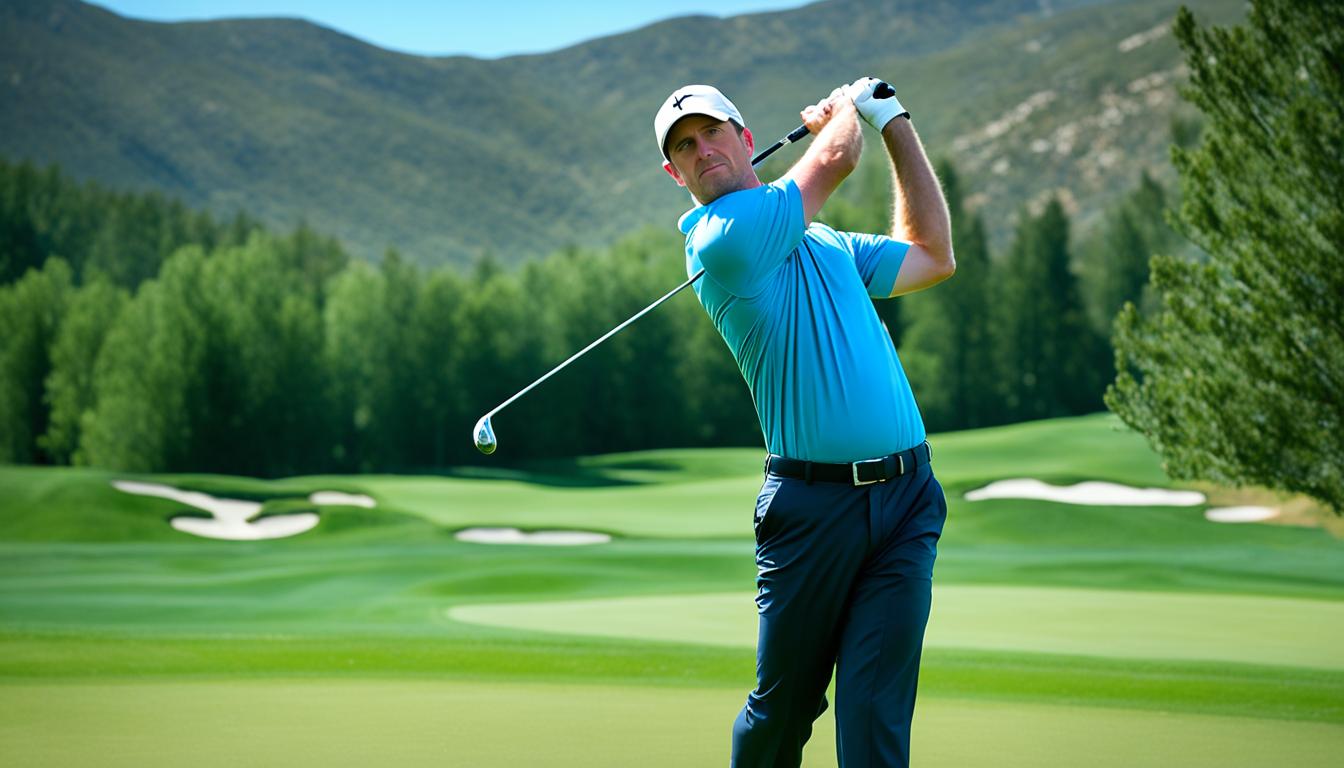Golf has witnessed a remarkable evolution, with players hitting the ball farther than ever before. Advancements in equipment and the influence of professional golfers like Bryson DeChambeau have contributed to this increase in distance. Recognizing this trend, organizations like the USGA and R&A have acknowledged the growing distance arms race in the sport. Whether you’re a professional or an amateur golfer, improving your tee shot range is crucial for elevating your game. In this article, we’ll explore expert tips and techniques to help you drive the ball for more distance off the tee.
Key Takeaways:
- Increasing backswing speed can lead to a longer swing and more time to accumulate speed on the downswing.
- Staying back longer during the downswing while accelerating the arms, wrists, and club can result in a higher launch angle and more distance.
- Proper shoulder tilt at address sets up an optimal swing path for maximum distance off the tee.
- Making harder practice swings can enhance clubhead speed and potential distance.
- Optimizing technique and leveraging key power moves can help improve clubhead speed and launch angle for more distance off the tee.
Increase the Speed of Your Backswing
If you want to improve your tee shot range and maximize your distance off the tee, one effective strategy is to focus on increasing the speed of your backswing. By generating more intensity in your backswing, you can achieve a bigger hip and shoulder turn, which in turn leads to a longer swing and more time to accumulate speed on the downswing. This increased speed in your backswing translates to a higher clubhead speed at impact, resulting in longer drives.
To understand the mechanics behind this technique, think of your backswing as a coiled spring. The more energy you put into coiling the spring during your backswing, the more power it will release on the downswing. This power transfer generates increased clubhead speed, resulting in greater ball speed and, subsequently, more distance.
Additionally, a faster backswing requires a larger muscular contraction to slow down the club and body in the transition phase, similar to a vertical jump. This muscular contraction not only helps control the club’s momentum but also allows for a more explosive downswing. By utilizing the larger muscles of your body effectively, you can generate more clubhead speed and maximize distance off the tee.
If you’re looking for some practical tips to help increase the speed of your backswing, here are a few key points to focus on:
- Stay relaxed: Tension in your muscles can hinder the speed and fluidity of your backswing. Maintain a relaxed grip and posture throughout the swing for a more effortless and faster motion.
- Use your body: Engage your hips, shoulders, and core in the backswing to generate power and create a wide arc. This will allow for a longer swing and increased clubhead speed.
- Practice tempo: Work on finding the right balance between a quick and controlled backswing. Experiment with different tempos to find what works best for your swing.
- Seek professional guidance: Consider taking lessons from a golf instructor who can provide personalized insights and guidance on improving your backswing technique and increasing clubhead speed.
Remember, increasing the speed of your backswing is just one piece of the puzzle when it comes to maximizing your tee shot range. Stay tuned as we explore additional strategies and techniques to help you boost your driving distance in the upcoming sections.
Stay Back Longer During the Downswing
Another power move that can help increase your tee shot range is to keep your trail shoulder back longer during the downswing while accelerating the arms, wrists, and club through impact. Many golfers rely solely on their torso to deliver the club to the ball, missing out on the firing power available from the arms and wrists. By staying back and releasing the club with acceleration, you can achieve a higher launch angle with less spin, resulting in more distance off the tee.
When you stay back longer during the downswing, you allow your trail shoulder to rotate more and create a wider swing arc. This additional rotation and extension of the arms and wrists contribute to increased clubhead speed, generating more power and distance. It’s important to maintain strong core stability to support this movement and prevent any unwanted sway or lateral movement.
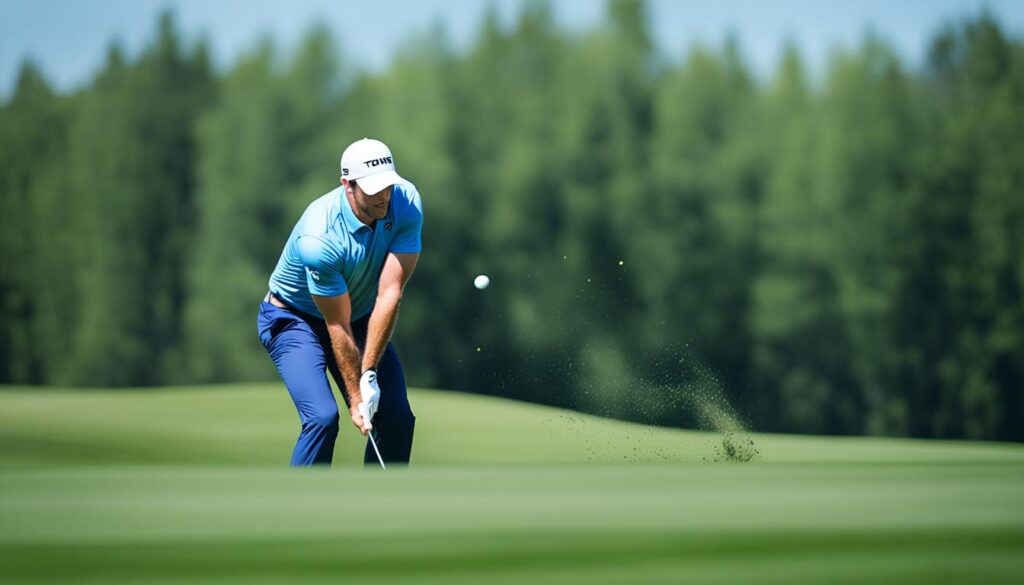
To practice staying back longer, focus on initiating the downswing with your lower body while maintaining the coil between your upper and lower body. As your hips begin to rotate towards the target, resist the temptation to overuse your upper body and instead allow your trail shoulder to lag behind, creating a dynamic sequence of motion.
As you approach impact, accelerate your arms, wrists, and club through the ball, keeping your trail shoulder back and maintaining a connected and powerful release. This downswing acceleration combined with the proper launch angle maximizes the energy transfer to the ball, propelling it with increased speed and distance.
Remember, the key to staying back longer during the downswing is maintaining proper sequencing and tempo. Focus on developing a smooth transition from your backswing to your downswing, allowing your power moves to flow naturally. Practice this technique on the driving range and incorporate it into your overall swing for consistent results.
By mastering the art of staying back longer during the downswing and utilizing the power of your arms and wrists, you’ll unleash your full potential for increased distance off the tee.
Proper Shoulder Tilt at Address
Setting the correct shoulder angle at address can significantly increase your distance on tee shots. When positioning the ball forward in your stance, align it with the instep of your lead foot. This placement naturally tilts your shoulders back and away from the target, with your lead shoulder slightly higher than your trail shoulder. This subtle tilt in your setup allows for a proper swing path into the ball, enabling the club to smash into the back of the ball and deliver maximum distance off the tee.
While it may appear visually unusual at first, this shoulder tilt is a fundamental starting position that facilitates a more athletic and powerful swing, optimizing your set up for launch.
Step-by-Step Guide: Proper Shoulder Tilt
- Position the ball forward in your stance, aligned with the instep of your lead foot.
- Allow your shoulders to naturally tilt back and away from the target.
- Ensure your lead shoulder is slightly higher than your trail shoulder.
- Maintain this shoulder tilt throughout your swing, focusing on a smooth and fluid movement.
By incorporating this shoulder tilt into your address position, you can optimize your swing path, enhancing your potential for increased distance off the tee.
Make Harder Practice Swings
One simple yet effective way to increase clubhead speed and achieve more distance off the tee is by making harder practice swings. By moving the club faster, you enhance the opportunity for increased distance. To implement this technique:
- Hold the club head at knee level
- Swing it back and through at that height
- Aim for a loud swooshing sound
As the sound gets louder, the clubhead speed increases, indicating the potential for more distance off the tee. By practicing these harder swings, you can improve your clubhead speed and overall distance.
Keep in mind that this is a practice exercise to enhance your swing mechanics and power. It is important to maintain proper form and technique while practicing these swings to avoid any strain or injury. Incorporate them into your regular practice routine and observe the positive impact on your tee shots.
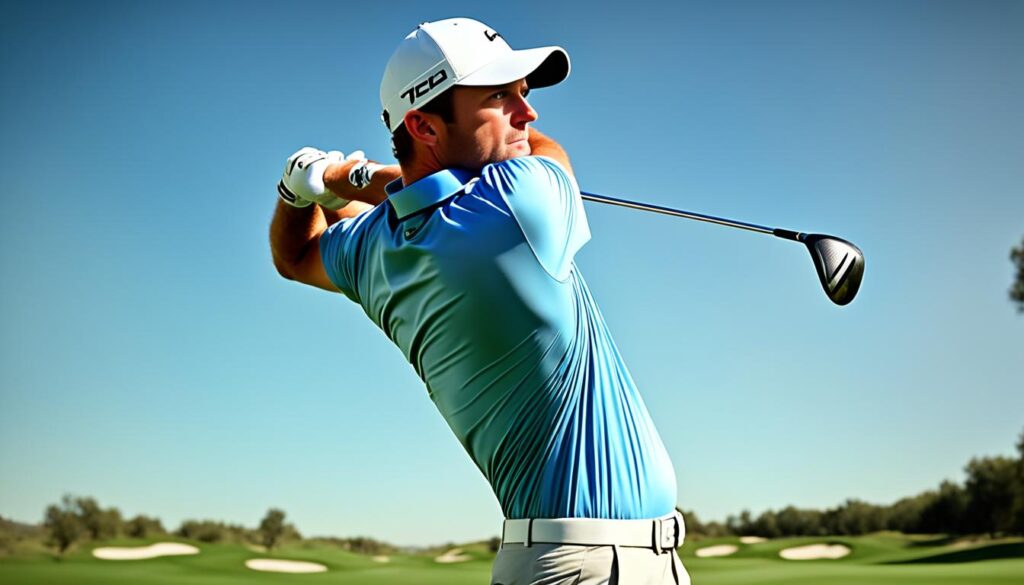
Expert Tip
“When making harder practice swings, focus on generating speed through the entire swing motion, from the backswing to the follow-through. Emphasize a smooth and flowing rhythm, allowing the speed to build gradually. It’s not about swinging harder with brute force, but rather about generating clubhead speed using the correct sequencing of body movements.”
| Benefits of Harder Practice Swings |
|---|
| Increased clubhead speed |
| Greater potential for distance off the tee |
| Improved swing mechanics |
| Elevated power generation |
Conclusion
Increasing your tee shot range is essential for golfers looking to elevate their game. By incorporating expert techniques such as increasing backswing speed, staying back longer during the downswing, setting the correct shoulder tilt at address, making harder practice swings, and utilizing your wrists, you can enhance your clubhead speed and launch angle, ultimately resulting in greater distance off the tee.
Remember, it’s not about swinging harder, but about optimizing your technique and leveraging key power moves. By honing these skills, you’ll be able to maximize your tee shot range without sacrificing accuracy. Practice the recommended tips consistently and observe the significant improvements in your drives as they dominate the fairway.
So, what are you waiting for? Get out there, focus on increasing your tee shot range, and watch as your shots soar to new lengths. With dedication and proper technique, you’ll soon become a force to be reckoned with on the golf course. Good luck!
FAQ
How can I increase the speed of my backswing?
To increase the speed of your backswing, focus on generating more intensity in your swing, which leads to a bigger hip and shoulder turn. This results in a longer swing and more time to build up speed on the downswing.
What is the benefit of staying back longer during the downswing?
By keeping your trail shoulder back longer during the downswing and accelerating your arms, wrists, and club through impact, you can achieve a higher launch angle with less spin, resulting in more distance off the tee.
How should I set up my shoulders at address for maximum distance?
Position the ball forward in your stance and align it with the instep of your lead foot. This will tilt your shoulders back and away from the target, with your lead shoulder higher than your trail shoulder. This setup allows for a proper swing path into the ball and maximizes the distance of your tee shots.
How can I make harder practice swings to increase my clubhead speed?
Hold the club head at knee level and swing it back and forth at that height, aiming for a loud swooshing sound. As the sound gets louder, it indicates an increase in clubhead speed and the potential for more distance off the tee.
What are some key techniques for increasing tee shot range?
Some key techniques for increasing tee shot range include increasing backswing speed, staying back longer during the downswing, setting the correct shoulder tilt at address, making harder practice swings, and utilizing the power of your wrists. These techniques help optimize your swing and maximize your clubhead speed and launch angle.
How important is increasing tee shot range in golf?
Increasing tee shot range is crucial for any golfer looking to enhance their game. By increasing distance off the tee, golfers can achieve better positioning on the fairway and set themselves up for more successful approach shots to the green.
